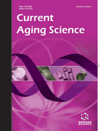- Home
- A-Z Publications
- Current Aging Science
- Previous Issues
- Volume 4, Issue 2, 2011
Current Aging Science - Volume 4, Issue 2, 2011
Volume 4, Issue 2, 2011
-
-
Role of the Immune System in Aging and Longevity
More LessAuthors: Patricia Alonso-Fernandez and Monica De la FuenteThe aging process is a universal, intrinsic, progressive accumulation of deleterious changes in cells and tissues that increases morbidity and leads to death. The heterogeneity of the age-related physiological changes is shown by the “biological age”, which determines the rate of ageing experienced by each individual and therefore his life expectancy. According to the recent theory of oxidation-inflammation to explain th Read More
-
-
-
Oxidative Stress and Skeletal Muscle Dysfunction with Aging
More LessAuthors: Wataru Aoi and Kunihiro SakumaWith advanced of age, production of reactive oxygen species increases in muscle tissues, which causes a continuous elevation of oxidative stress in the muscle. Such oxidative stress brings damage by oxidation of cell components such as lipids, proteins, and DNA. Growing evidences suggest that oxidative stress affects energy metabolism, protein degradation, and apoptosis in the muscle via transcriptional and posttranslation reg Read More
-
-
-
Glaucoma and Aging
More LessAuthors: Guilherme Guedes, James C. Tsai and Nils A. LoewenAge is an established major risk factor for glaucoma that can be used along with other data to compute chances of developing glaucoma. This leading cause of blindness is becoming increasingly more prevalent in the aging population. The characteristic progressive degeneration of the optic nerve in glaucoma is primarily caused by increased intraocular pressure yet the cause for the reduced outflow is not well understo Read More
-
-
-
Role of Insulin Signaling in the Interaction Between Alzheimer Disease and Diabetes Mellitus: A Missing Link to Therapeutic Potential
More LessDiabetes mellitus (DM) is one of the major non-genetic risk factors for Alzheimer disease (AD). However, the mechanism by which DM increases the risk of AD has not been elucidated. Here, we summarize recent findings to address this question. Whereas neuropathological studies in humans suggest that DM does not increase Aβ accumulation in the brain (a major hallmark of AD), earlier works in animal models show that Aβ Read More
-
-
-
The Role of Cellular Senescence During Vascular Calcification: A Key Paradigm in Aging Research
More LessAuthors: N. C.W. Mackenzie and V. E. MacRaeVascular calcification has severe clinical consequences and is considered an accurate predictor of future adverse cardiovascular events. Vascular calcification refers to the deposition of calcium phosphate mineral, most often hydroxyapatite, in arteries. Extensive calcification of the vascular system is a key characteristic of aging. In this article, we outline the mechanisms governing vascular calcification and highlight its associ Read More
-
-
-
Sensory-Dependent Knowledge in Young and Elderly Adults: Argument from the Cross-Modal Priming Effect
More LessAuthors: Guillaume Vallet, Martine Simard and Remy VersaceThe nature of knowledge, i.e. sensory-dependent or abstract, is controversial. Growing evidence supports the existence of sensory-dependent knowledge in young individuals, but this question remains unexplored in elderly individuals. Thus the first objective of this study was to assess sensory-dependent knowledge in normal aging using a cross-modal priming paradigm. The cross-modal priming is a way to verify the na Read More
-
-
-
Effects of a Long-Term Treatment with an Antioxidant Pyridoindole on Vascular Responsiveness in Diabetes-Induced Aging Rats
More LessImpaired vascular reactivity is a hallmark of cardiovascular diseases induced by diabetes, which is also an accelerated aging model. This study was designed to investigate the effect of chronic treatment of stobadine, a pyridoindole antioxidant, on vascular responsiveness in diabetic animals. Age- (13-week old) and gender-matched Wistar rats were randomly divided into control and diabetic groups. Streptozotocin (55mg/kg, i. Read More
-
-
-
Vitamin E and All-Cause Mortality: A Meta-Analysis
More LessThe current analysis reexamines the relationship between supplemental vitamin E and all-cause mortality. All randomized, controlled trials testing the treatment effect of vitamin E supplementation in adults for at least one year were sought. MEDLINE, the Cochrane Library, and Biological Abstracts databases were searched using the terms “vitamin E,” “alpha-tocopherol,” “antioxidants,” “clinical trial,” and “controlled trial” Read More
-
-
-
Evolution of Specific Cognitive Subprofiles of Mild Cognitive Impairment in a Three-Year Longitudinal Study
More LessAuthors: H. Peraita, S. Garcia-Herranz and C. Diaz-MardomingoThe present work addresses one of the currently most controversial aspects of early detection of Alzheimer's disease (AD) and other dementias; that is, the identification of the Mild Cognitive Impairment (MCI) syndrome—in some cases, prior to AD—in a sample of older subjects who are healthy from the cognitive viewpoint. In a three-year longitudinal study, we classified the participants between 58 and 90 years of age in Read More
-
Volumes & issues
Most Read This Month
Article
content/journals/cas
Journal
10
5
false
en

Most Cited Most Cited RSS feed
-
-
Polyphenols and Aging
Authors: Brannon L. Queen and Trygve O. Tollefsbol
-
- More Less

